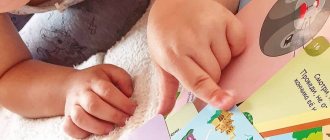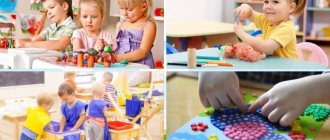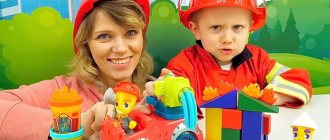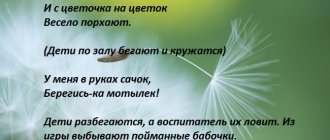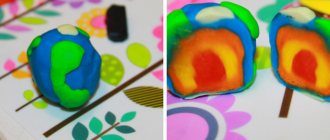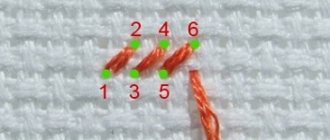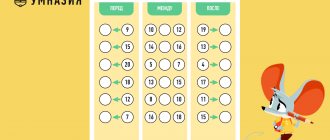The didactic game “Patterns” is intended for independent and joint lessons with a teacher by preschoolers of the primary and secondary groups. It develops concentration, observation, imagination, finger motor skills, and visual perception. The purpose of the game “Patterns” is to form ideas about different patterns, teach the skill of composing compositions, selecting elements by shape and color.
Didactic game “Fold the pattern”
There are several classes on this topic. They all perform the following tasks:
- are taught to put together a whole from several parts;
- introduce colors and shapes, their names;
- teach the skill of composing images based on a model;
- develop imagination, creative thinking, the ability to see images of the real world in abstract forms and lines;
- train the ability to analyze, compose, combine;
- improve concentration, spatial-temporal orientation, thinking ability, visual memory, finger motor skills;
- They teach you to cooperate, interact productively, and respond emotionally.
To play, you need to prepare a laminated image of the national ornament and cut it randomly into several parts.

At the preliminary stage, children look at book pictures depicting national patterns. Then the teacher suggests putting together an ornament from parts. To make it easier for preschoolers, there should be a sample in front of their eyes.

Didactic games for preschool children
Didactic games to familiarize children with Tatar ornaments
Didactic game “Find a pair” (dominoes)
Purpose of the game:
Teach children to find identical pictures and connect them into chains. Fix the name of the elements of the Tatar ornament.
Develop attention, observation, logical thinking. Cultivate interest in the art of the Tatar people.
Rules of the game:
Dominoes are a fun board game that uses tiles. This plate is divided into two parts, the domino set includes 28 plates.
The game is designed for 2-4 players. The plates are mixed. Each player takes 6 cards. The remaining cards are in the “reserve” in the middle. Each player takes turns, clockwise, lays out 1 card so that one of the card pictures is the same as one of the outer pictures on the playing field. If the player does not have a suitable card, then he goes to the “reserve” and takes cards until he finds the one he needs. If there are no more cards in the “reserve” the player skips his turn. If no player can move, the game is over.

Didactic game “Make a pattern on a napkin”
Purpose of the game:
Teach children to make a Tatar national pattern or ornament on a napkin.
Develop the ability to compose beautiful compositions. Enrich children's vocabulary with the names of the Tatar national ornament. Develop fine motor skills and hand-eye coordination.
Cultivate interest in the history of the Tatar people and their traditions
Rules of the game:
The game uses “napkins” of white, yellow and red colors, elements of the Tatar ornament - tulips, bells, leaves.
Option 1. Each player takes one “napkin” and, choosing elements of the Tatar ornament, lays out a pattern on it.
Option 2. The player is given a “napkin” with a pattern already laid out on it. He needs to lay out the same pattern on his “napkin”.

Didactic game “Find and name”
Purpose of the game:
Teach children to find and name the elements of the Tatar ornament: tulip, bell, leaf, and make pairs of them. Enrich children's vocabulary with the names of the Tatar national ornament.
Develop attention and memory.
Cultivate interest in the art of the Tatar people.
Rules of the game:
The game uses large, divided into two parts, and small cards. Each player takes 1-2 large cards. The small cards are shuffled.
Option 1 The presenter shows one small card at a time, naming the Tatar element that is depicted on it. Players must find the item on their big card, name it again, and place it on the second empty part of the big card.
Option 2 The presenter shows one small card at a time, without naming the Tatar element that is depicted on it. Players must find this item on their large card, name it, and place it on the second empty part of the card.
Option 3 Players are asked to find all the elements of a tulip (bell, leaf) on small cards, name this element and put them on the second empty part of the large card.
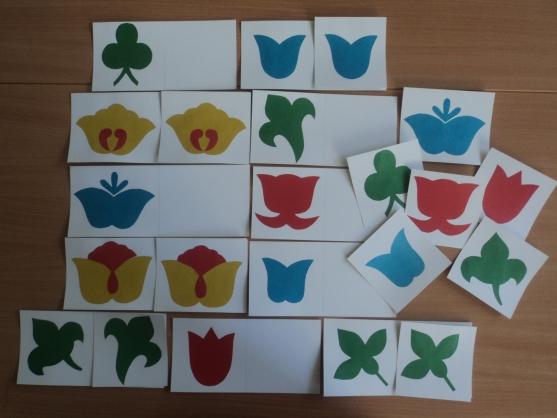
Didactic games to familiarize yourself with Tatar national ornaments
Didactic games to familiarize yourself with Tatar national ornaments
The folk applied art of the Tatars of the Middle Volga region, the origins of which are lost in the depths of centuries, has not preserved the names of hundreds and thousands of its craftsmen - embroiderers, weavers, shoemakers (ichizhniks). Much of what was created by their golden hands has not been spared by time.
The basis of the traditional Tatar ornament is floral and plant motifs, curvilinear geometric figures. Embroidery and leather applique are presented in many options: bell (kygyrau chchk); tulip (lal chchk); ram's horn (tk mgeze); eye (kz); heart (irk); 8-, 12-, 14-rayed stars (yldyz); head of a cat (dog bashi), etc.
In women's clothing, one of the main elements was the shirt (klmk). As a rule, the chest section, sleeves and bottom of the hem were embroidered. A sleeveless (or short-sleeved) camisole was worn over the shirt.
An apron used to be a mandatory element of work clothing, and for young women it was often a festive item.
The most common male headdress among the Tatars is the skullcap, and the most common female headdress is the kalfak.
Traditional shoes are leather ichigs and shoes with soft and hard soles.
I offer didactic games to familiarize yourself with Tatar national ornaments: “Make a pattern”, “Decorate clothes”; “Find and name”, “Find a pair”.
Program content:
• introduce Tatar national clothing and footwear;
• introduce children to bouquet arrangements, features of a set of flowers and leaves, color combinations;
• develop the ability to compose beautiful compositions;
• teach children to create a Tatar national pattern or ornament on an apron (camisole, kalfak, ichigi boots, skullcap, towel);
• enrich children's vocabulary with the names of the Tatar national ornament;
• cultivate interest in the history of the Tatar people and their traditions;
• develop fine motor skills, hand-eye coordination;
• work on perseverance;
• deepen concepts of size and color.
Didactic game “Assemble a pattern”
For the lesson you need to draw silhouettes of Dymkovo figures - a cockerel and a horse. Separately cut out the details of the Dymkovo pattern: circles of different colors and sizes, flowers, leaves, straight and winding stripes. Also, as a sample, you need to make pictures of toys with ornaments on them.
The teacher places full pictures of toys and empty silhouettes in front of the children, and lays out the cut-out parts on the table. He asks the students to carefully look at what the horse and cockerel look like and decorate the silhouettes in the same way.
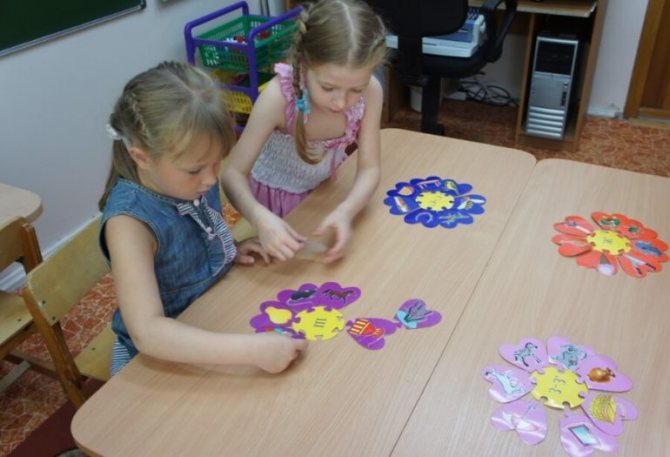
Children begin to consciously distinguish the shapes of objects already at the 2nd year of life, but are able to remember and correctly name a circle, rectangle or square only by the age of 3. This period is the most favorable for studying elementary geometric figures.The task can be complicated: remove the complete drawing so that the children can decorate the silhouettes from memory, or invite them to come up with their own ornament from the details.
Children of this age examine objects more carefully, identifying their distinctive features such as size, color and, of course, shape. But such skills require constant training.
Classes and didactic games aimed at developing concepts about the shape of objects should be conducted weekly, gradually complicating the tasks and thereby improving the children’s skills.
The teacher must not forget that children will learn the material more easily if they have bright and beautiful toys at hand. They will not only help you focus attention, but will also develop a desire to play with them, and this is so important in early preschool age.
By the age of 4–5, children’s understanding of basic geometric shapes is much broader, so they can be introduced to objects such as rhombus and trapezoid. At the same time, you can not say the name of the figure for now, but simply identify its distinctive features.
Later, in older preschool age, children will be able to independently compare objects and find similar figures among them.
Amazing circles
Purpose of the game:
introduce children to such a geometric figure as a circle, repeat the names of primary colors (red, blue, green and yellow) and sizes of objects, develop fine motor skills of the fingers, memory, the ability to focus attention on a specific object, teach how to fold a whole from the available parts at hand ( for example, a snowman).
Equipment:
mugs cut out of paper, different colors (red, blue, yellow and green) and different sizes (large, medium and small).
Age
: 3 years.
When the children concentrate on the lesson, they should be asked what they saw on their tables, what is the name of this figure. If the guys are familiar with the circle, they will immediately give the correct answer, but if not, then you need to explain it to them.
Then the leader checks how well the kids remember the names of the colors. When the children are ready to play, you can tell the rules of the game, which consist of quickly saying the name of a certain figure, what size and color it is.
The kid who gave the most complete and correct answer becomes the leader, chooses the next figure of a certain color and asks the rest of the children to find a similar one on their table and raise it above their head, then describe its properties in detail.
Thus, the drivers are constantly changing, and the teacher has time to monitor each child.
At the end of the game, you can ask the children to assemble a snowman themselves, using only 3 circles of different sizes. Eyes, nose and mouth can be drawn with a pencil.
Progress of the game:
The teacher invites the children to play together, but first they need to take their places at the tables and carefully examine the prepared material.
Colorful squares
Purpose of the game:
introduce children to such a geometric figure as a square, repeat the names of the main colors and sizes of objects, develop fine motor skills of the fingers, memory, and observation skills.
Equipment:
cardboard squares of different colors (red, white, blue, yellow and green), different sizes (large, medium and small); several circles made of the same material; sample square measuring 30 x 30 cm.
Age
: 3 years.
Progress of the game:
The leader invites the children to listen to the rules of the game, with the help of which they will learn to correctly identify squares and find them among other figures.
To do this, the teacher shows the children a large sample square and asks them to carefully examine and tell what is special about this figure. If the children did not see that the sides of this figure are the same, then this must be mentioned, since this is the main distinguishing feature of the square.
When the children have mastered this material, you can ask them to classify all the figures on their tables into categories. Place red squares on one side, blue squares on the other, and green squares on the third. When the work is completed, the teacher should check it and praise each child.
You can give the task to distribute the available squares into groups depending on their size. Here the children will also get 3 categories.
By the end of the game, the children, as a rule, learn the name and shape of the square very well, so you can do a little test: ask the kids to mix the squares and circles together, and then in a short time arrange the circles separately and the squares separately.
Magic rectangles
Purpose of the game:
introduce the children to the rectangle, repeat the names of the primary colors (red, blue and yellow) and the sizes of objects, develop fine motor skills of the fingers, memory, and observation skills. Develop children's speech and ability to construct complex sentences.
Equipment:
rectangles cut out of cardboard, different colors (red, blue, yellow and green) and different sizes (large, medium and small) for each child; circles and squares for comparison; large rectangle 20 x 40 cm for sample.
Age
: 3 years.
Progress of the game:
Children have sets of rectangles of different sizes and colors on their tables. The teacher invites the children to carefully examine them and say which figure, studied earlier, the rectangles are more similar to - a circle or a square (the children say that they are a square).
The next step is to compare the rectangles in size and say that they can be used to build a large pyramid. You can offer to do this task yourself, but first the leader explains that the largest rectangle should be at the bottom, then a smaller one, and the smallest one at the very top.
When the children learn to select rectangles from the proposed shapes, you can invite them to play a game, the rules of which are to clap their hands when a rectangle is shown, and sit quietly if it is any other shape.
The teacher takes turns showing the children different figures, and they, in turn, clap or do not react to it, depending on what was shown.
Triangles, or roofs
Purpose of the game:
introduce children to such a geometric figure as a triangle, repeat the names of primary colors (red, blue and yellow), as well as the sizes of objects, develop memory, observation, and fine motor skills of the fingers.
Equipment:
cardboard triangles of different colors (red, blue, yellow and green) and different sizes (large, medium and small); a set of cubes of different shapes for building a house, a toy (baby elephant).
Age
: 3 years.
Progress of the game:
The leader gathers the guys together and offers to help the baby elephant build a house. To do this, you need to lay out the walls, don’t forget about the window and door. Then the teacher asks what is missing in the built house, to which the children answer: “There is no roof.” Now you should ask the guys what shape the roof should be - round or triangular. When the kids answer the question, you can ask them to choose the required cube from the set and complete the house. This is how children come to the conclusion that the triangle is similar to the roof of a house, which helps them better remember the feature of the figure.
After this, it is necessary to consolidate the children’s knowledge about the new shape of the object for them - triangular. To do this, you should offer to play together. The rules of the game are as follows: the leader shows a figure of any shape (triangle, square, circle, rectangle), and the guys find the same one in their sets and say its name. If the teacher shows a triangle, then it must be placed separately from the others. Thus, the guys get two groups of objects: triangles and all the rest.
If the children have well understood the difference between a triangle and, for example, a rectangle, then you can ask them to independently find the differences, which lie primarily in the number of sides and angles in the figure.
Build a house
Purpose of the game:
develop fine motor skills of fingers, memory, the ability to focus attention on a specific object, teach weaving with various threads, develop children’s speech, teach them to distinguish shapes such as triangle, square and rectangle.
Equipment:
cardboard plates measuring 20 x 30 cm with holes made at a distance of 2-3 cm from each other, parts for assembling the house (square, window, large triangle), thick threads for weaving, a sample of assembling the house for each child.
Age
: 3–4 years.
Progress of the game:
The teacher invites the children to carefully examine the sample that he shows to everyone, and the items that are prepared on the tables.
The next step is for the leader to choose from those offered only those parts that will be needed to assemble the house (triangle, square, rectangle). Next, you need to take a thick thread and place the square on the board so that the holes in the parts match. Now the guys carefully sew the part. Then the roof and window are attached in the same way.
Making a house in this way not only develops fine motor skills of a child’s hand, but also helps to become more attentive and learn to focus on an object for quite a long time.
Name the figure
Purpose of the game:
develop imagination, memory, attention, the ability to identify an object by its characteristics, increase children's vocabulary, develop logical thinking, systematize children's knowledge about geometric objects such as triangle, rectangle, circle and square.
Equipment:
a large sheet with drawn cats made from different geometric shapes: heads - circles, noses - triangles, eyes - ovals, mouth - rectangle, etc. You can depict several cats, made in different ways.
Age
: 4–5 years.
Progress of the game:
The teacher shows the children a poster and asks them to carefully look at the drawings, then say what is shown on them. Despite the fact that the animals are made differently, the children say that these are cats, since they have peculiar triangle ears that only these animals have.
Then the leader tells the kids that they need to name the figures that make up the cats and compare the proposed drawings with each other. Once the children have completed the tasks, you can ask them to draw any other animal on the board with chalk, using only rectangles, squares, circles and triangles. This task is quite difficult, so the kids will need the help of a teacher.
Do it yourself!
Purpose of the game:
to develop in preschoolers imagination, speech, the desire to use existing knowledge, strengthen counting skills to 10, the ability to play in a group of peers, and develop independence in collecting various geometric shapes.
Equipment:
10 counting sticks for each child, patterns for collecting square, rectangle, triangle, pentagon and trapezoid or rhombus.
Age
: 5–6 years.
Progress of the game:
The teacher gathers the children and invites them to play a game together that will require their concentration and observation. First, the children carefully examine the patterns of collecting squares, rectangles, and triangles from counting sticks (if the group of children is sufficiently developed, you can invite them to assemble a trapezoid or pentagon on their own).
Then the children pay attention to how many sticks are needed to assemble the various shapes, and begin to make squares on their own. After the teacher checks and evaluates all the work, you can begin to make a rectangle or diamond.
Thus, during one lesson, children not only assemble geometric shapes from available material, but also better assimilate their distinctive properties.
A similar game can be organized a little differently. First, you should divide the guys into 2 teams and come up with a name for each that would be related to the theme of the game. Next, the teacher offers groups of children tasks that can be as follows:
1) add as many shapes as possible from the 10 available sticks;
2) what figure can be made from 5 counting sticks? Collect it;
3) how to divide a square using 1 stick into 2 triangles?
4) try to collect 2 squares using only 7 counting sticks;
5) other tasks.
Find all the triangles
Purpose of the game:
continue to familiarize children with such geometric shapes as square, rectangle and triangle, consolidate knowledge about primary colors (red, blue, green, yellow), make children want to play together, develop thinking, memory, attention, speech.
Equipment:
an equilateral triangle with sides 30–40 cm long, drawn on whatman paper or cut out of thick cardboard. Its peculiarity is that it is divided by three thick lines emerging from the corners of the triangle; 2-3 small triangles for each baby.
Age
: 5–6 years.
Progress of the game:
The leader invites the children to look at the prepared figure and say its name. Then the teacher draws special attention to the children that this triangle is divided into parts by three lines. It is necessary to say what shapes were obtained.
If it is difficult for the children to see these triangles, then they can be painted in different colors, which will help count the number of figures obtained. When the children complete the task, you can ask them to independently put together a new shape from 2-3 triangles (this can be a triangle, a square and a rectangle).
Guess the item
Purpose of the game:
develop imagination, memory, attention, the ability to play in a group of peers, the ability to identify an object by its characteristics, increase children's vocabulary, develop logical thinking, systematize children's knowledge about geometric objects such as triangle, rectangle, circle and square.
Equipment:
several toys familiar to children, a bag in which the prepared items will be placed.
Age
: 6–7 years.
Progress of the game:
The leader invites the children to play scouts, but to do this they need to choose a driver. Then you can explain the rules of the game, which are to guess the object by touch.
The teacher brings into the group a bag of toys that the children have already seen before and are familiar with. Then the driver puts his hand into the bundle and selects one of the toys, but does not take it out, but tries to identify it by touch.
If the baby guesses what kind of item is in the bag, he takes it out and gets a chance to guess another toy, but no more than two times in a row. Then the turn passes to another participant. If the child could not guess the first time, the teacher begins to describe in detail all the properties of the object, and the rest of the participants try to guess what exactly is there.
If this game turns out to be quite simple for kids, then you can complicate it a little by putting toys in a bag that the kids have only seen a few times. If they are able to do this, then the teacher can, without showing the object, talk about it in detail, and the children ask leading questions. The child who guesses what is being said the fastest wins.
What figure is missing?
Purpose of the game:
develop memory, attention, observation, quick thinking, the ability to find small changes that have occurred in objects, repeat the names of colors and their shades, and develop children’s speech.
Equipment:
a sheet of whatman paper divided into 12 equal rectangles so that there are 4 cells horizontally and 3 vertically; 12 small cards - rectangles, squares, circles and triangles of different colors.
Age
: 6–7 years.
Progress of the game:
The leader invites the children to carefully examine the figures that lie on the tables and say their name and color.
Then the teacher, with the help of the children, fills in the empty cells of the table. To do this, the leader asks one of the children to pick up any free piece and place it in a free cell. When the cards run out, the children carefully look at the resulting canvas and remember in what order the objects are located.
After this, the leader asks the children to close their eyes for a few seconds. At this time, the teacher removes one of the cards, then invites the children to restore the order of the figures. If the guys cannot remember which figure and what color was in the cell, then they can calculate it, because there were equal numbers of all the figures and they were all different colors.
To test children's observation skills, you can place 2 identical cards in the cells while the children close their eyes, and then ask them to find them. The fastest, most observant and dexterous guys win the game.
Find the odd one out
Purpose of the game:
teach children to group objects according to common characteristics, develop the ability to identify objects that do not meet certain requirements.
Equipment:
various geometric shapes for hanging on a magnetic board - squares of different sizes, rectangles, quadrangles and pentagons of different shapes, equilateral, isosceles, rectangular triangles, circles, ovals, etc.
Age
: 6–7 years.
Progress of the game:
The leader places the prepared geometric figures one at a time on the magnetic board and asks the children to say what they are called. The teacher then places several shapes in a row (for example, a square, a quadrilateral, a diamond, and a triangle) and then asks what is missing. If the guys find it difficult to answer, then the leader can offer to count the number of sides and angles of the proposed figures.
At the next stage, the teacher lays out the geometric shapes in a different order (for example, among triangles of different shapes he places a circle or an oval) and invites the children to determine what is superfluous there and why. You can offer other combinations of figures:
1) circles, ovals of different sizes and a square;
2) quadrangles, and triangle, pentagons;
3) rectangle, square, rhombus, trapezoid and triangle;
4) other options.
A similar game can be played not only with geometric shapes, but also with various objects that have different properties.
Didactic game “Pick a pattern”
For the lesson, prepare game material:
- take light A4 cardboard and white plastic drink lids;
- Divide the cardboard sheet into squares of equal size;
- there should be one cap for each sector;
- With a black marker, draw a pattern on each square, similar on the corresponding lid (it should not be repeated on other squares and lids);
- Laminate cardboard with transparent adhesive tape to extend its service life.
The players' task is to find a suitable cap for each square. The activity is exciting, preschoolers play willingly, thereby developing memory, concentration and perseverance.
